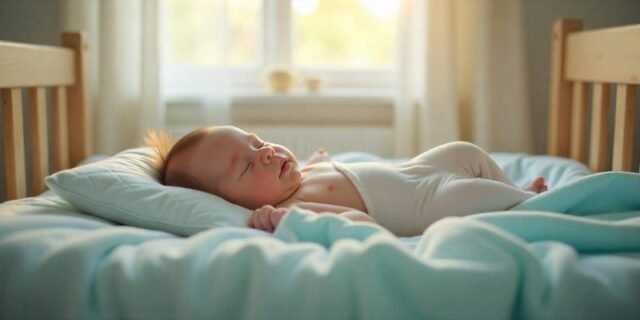When it comes to your baby’s comfort and safety, every small detail matters — especially when it involves sleep. A baby pillow isn’t just a cute addition to your child’s bedding; it’s a tool to support healthy development, posture, and restful sleep. However, not all pillows for kids are created equal. In this guide, we’ll explore how to choose the best baby pillow for your child, the different types available, safety tips, and what to avoid.
When Should a Baby Start Using a Pillow?
One of the most common questions parents ask is: “At what age can my baby use a pillow?” Pediatricians typically recommend introducing a baby pillow only after 18 months to 2 years of age. Before that, infants should sleep flat to minimize the risk of suffocation or SIDS (Sudden Infant Death Syndrome).
However, once your child moves into the toddler phase, the right child pillow can enhance sleep quality and provide the needed neck support.
Benefits of Using a Kids Pillow
While many assume pillows are only for comfort, using a butterfly pillow for kids provides multiple developmental and health benefits, such as:
- Spinal Alignment: A supportive pillow ensures the neck, head, and spine align correctly, especially during growth.
- Improved Sleep Quality: Comfortable pillows for kids help reduce restlessness, leading to deeper sleep.
- Allergy Prevention: Many baby pillows today come with hypoallergenic materials that reduce allergens and skin irritants.
- Behavioral Benefits: Well-rested children are generally happier and more attentive throughout the day.
Types of Baby Pillows: What Are Your Options?
There’s a wide range of baby and kids pillows in the market, each designed for specific needs. Here’s a breakdown of common types:
A. Flat Head Baby Pillow
Specifically for newborns, these pillows are designed to prevent or reduce flat head syndrome. They cradle the baby’s head while distributing pressure evenly.
B. Toddler Pillow
These are the most common pillows for kids aged 2 and above. They are smaller than adult pillows and filled with hypoallergenic materials for added safety.
C. Memory Foam Pillows
Some child pillows come with memory foam to provide better contouring support. Ensure it’s certified safe for kids and doesn’t retain too much heat.
D. Organic or Hypoallergenic Pillows
Perfect for sensitive skin and allergies, these baby pillows are made from natural fibers like cotton or bamboo and avoid harsh chemicals.
Key Features to Look for in a Baby Pillow
Choosing the right pillow for baby involves more than just softness. Here’s what to keep in mind:
A. Size
Opt for a size specifically designed for children — usually around 13×18 inches. A pillow that’s too big can strain the neck or cause discomfort.
B. Firmness
A firm yet comfortable pillow is essential. Soft pillows may feel cozy but can pose a suffocation risk, especially for younger toddlers.
C. Material
Look for breathable, hypoallergenic, and chemical-free materials. Memory foam, microfiber, and organic cotton are great options for pillows for kids.
D. Washability
Babies and toddlers are messy. A machine-washable child pillow or one with a removable cover can save time and maintain hygiene.
Top Safety Tips for Using a Baby Pillow
Safety is crucial, especially for young children. Here are some best practices:
- Avoid using pillows for babies under 18 months.
- Use a firm, flat pillow that doesn’t retain too much heat.
- Ensure there are no zippers, buttons, or decorative elements that can be a choking hazard.
- Always monitor your baby during naps if a pillow is newly introduced.
- Keep the sleeping area free of additional bedding items like stuffed toys or extra blankets.
Common Mistakes Parents Make When Choosing a Kids Pillow
It’s easy to go wrong when selecting a pillow for kids, especially with so many cute and cozy options available. Avoid these pitfalls:
- Buying too early: Introducing a pillow before it’s developmentally appropriate can be dangerous.
- Picking the wrong size: Oversized pillows can misalign the spine.
- Ignoring material safety: Always check for certifications like OEKO-TEX or GOTS to ensure the pillow is toxin-free.
- Overlooking maintenance: If it can’t be washed easily, it may not be ideal for messy little sleepers.
Conclusion: A Better Pillow for a Better Sleep
Choosing the right baby pillow is an investment in your child’s comfort, safety, and long-term health. From toddler pillows to hypoallergenic options, there are several choices out there — but what matters most is safety, proper support, and material quality.
Whether you’re shopping for a kids pillow, a pillow for kids entering preschool, or a special child pillow for allergy concerns, the best decision is one informed by both pediatric advice and your child’s individual needs.
FAQs
1. Is it safe for a 1-year-old to use a pillow?
Generally, it’s advised to wait until the child is at least 18 months old before introducing a pillow. Always consult your pediatrician for specific recommendations.
2. How do I clean a baby pillow?
Most toddler pillows come with removable, washable covers. Some pillows themselves are machine washable. Always follow the manufacturer’s instructions.
3. What size is a toddler pillow?
The standard toddler or kids pillow size is around 13×18 inches, perfect for smaller heads and beds.
4. Can a child use an adult pillow?
No. Adult pillows are too large and thick, which can misalign a child’s spine and cause discomfort.
5. What is the best material for a baby pillow?
Organic cotton, bamboo fabric, or hypoallergenic memory foam are ideal choices due to their breathability and safety.







